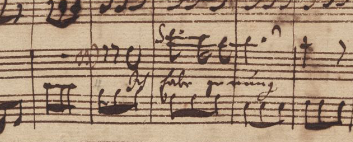Playlist
Complete Performance
Translation
| German Text | English Text |
|---|---|
| German Text | English Text |
Analysis
There is some debate as to whether the words are 'Ich habe genug' or 'Ich habe genung' (as here presented). Genug is the modern German for 'enough' (as in 'he has money enough' or 'that's enough, thank you!') and many Bach cantata listings or articles will cite it as 'genug' (see, for example, this one or this one), but it's definitely written in the original manuscript as 'genung', with the extra 'n':
You may well have to squint to see it, but in the fifth bar shown above, it's definitely 'something-u-n-g'. Most modern German/English dictionaries prefer the n-less version, but you can find the n-version too, if you look hard enough! I don't think it makes a profound difference to meaning, though, either way: in both cases, the sense is of "I have a sufficiency (of material things)", rather than "I've had enough of this, so I'm off out of here!", though the cantata's strong emphasis on welcoming death might lead you to think of the second sense at times. It is, then, a cantata about having a fulfilment of desire rather than being fed up with life.
The cantata was originally written for performance in 1727; it was then brought out from the bottom drawer on multiple subsequent occasions, being revised each time in various ways. Whilst the bass has the starring role in the 1727 C minor version, the 1731 revision made it a solo soprano cantata in E minor. In 1735, it became a mezzo-soprano cantata in C minor and E minor (for two closely-spaced performances) and in 1746, it reverted to being a bass cantata in C minor, closely based on the 1727 original. So clearly the work was popular over an extended period! As you will probably be able to tell easily enough, the audio excerpts presented above are from the 1727 version, for bass.
The multitude of voices used for the piece over the years perhaps reflects some ambivalence in Bach himself from the very start: the 1727 version is actually notated to begin with in the alto clef, with a hand-written note at the bottom of the first page explaining his switch to bass voice for his copyist, before going on to notate the rest of the work for the bass voice:
I'm not especially good at reading Bach's hand-writing, but that's definitely an alto clef at the start of the top line of the manuscript displayed there, and even I can read "Bass transpos..." as the last part of the 'NB' line of hand-writing. Personally, I think the bass version lovely and velvety, which is never going to be true for even the loveliest soprano voice! On the other hand, the lowest notes for the bass part are very low and can get lost in the orchestration, despite its simplicity, unless the singer is top-notch. The soprano version also uses flutes rather than the much-more-mournful oboes, which can affect how you feel about the work as a whole (I'm an oboe fan myself!)
If you would prefer to hear the soprano version, it can be bought in full at Amazon, and here are the audio excerpts for that version:
Regardless of the version you prefer, however, the music is of incomparable quality!
[More to come]
